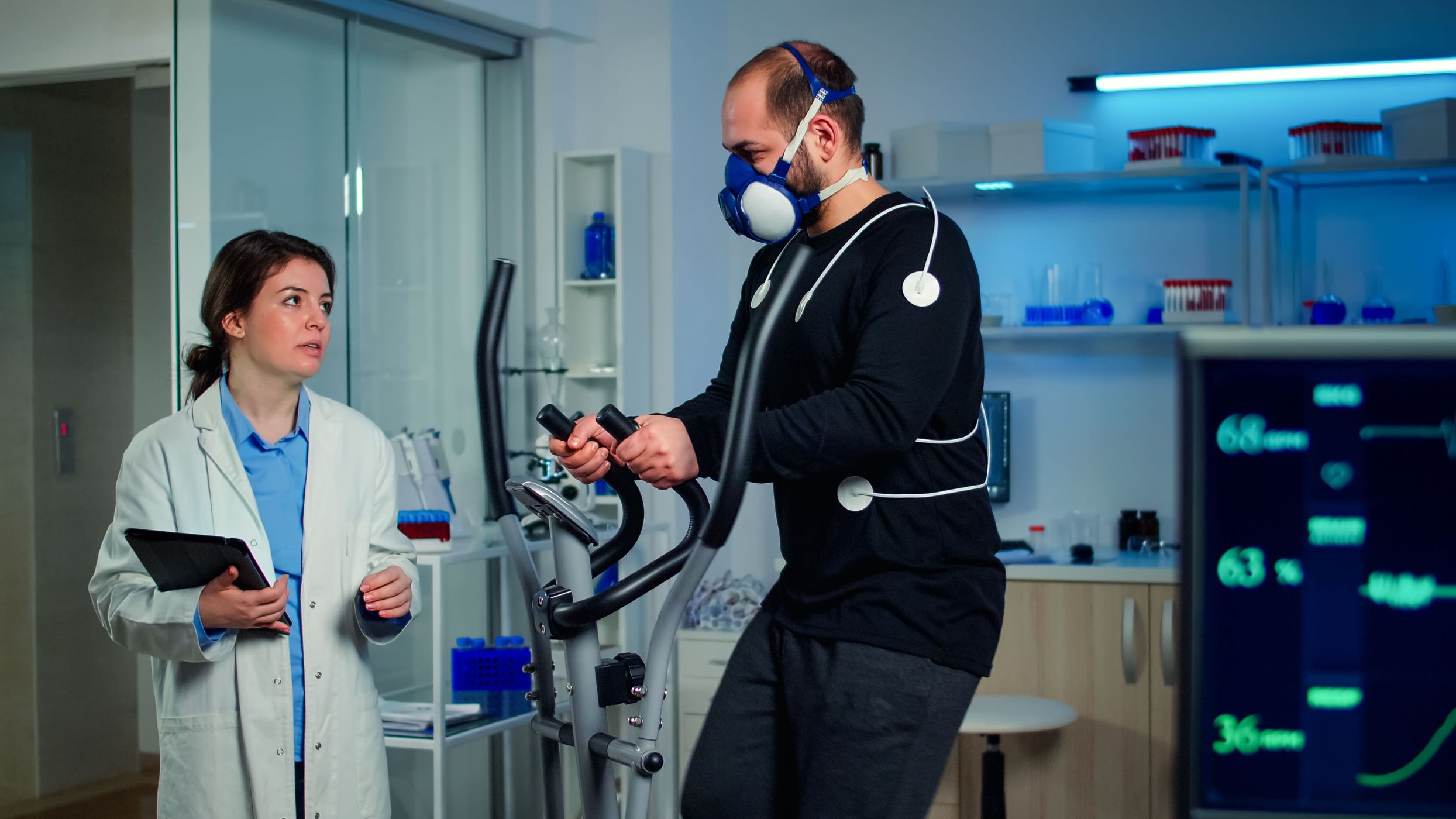Home>Misc>Featured>Why Is Cardiovascular Endurance Important


Featured
Why Is Cardiovascular Endurance Important
Modified: August 21, 2023
Discover the importance of cardiovascular endurance and how to improve it with our featured articles, tips, and exercises. Enhance your overall fitness and health today!
Introduction
Cardiovascular endurance is an essential component of overall fitness and plays a crucial role in maintaining a healthy and active lifestyle. From jogging in the park to swimming laps in the pool, activities that improve cardiovascular endurance can have numerous benefits for both physical and mental well-being. Whether you’re a seasoned athlete or just starting your fitness journey, understanding the importance of cardiovascular endurance can motivate you to incorporate regular aerobic exercise into your routine.
Cardiovascular endurance refers to the ability of your heart, lungs, and circulatory system to deliver oxygen and nutrients to your muscles during prolonged physical activity. It is a measure of how efficiently your body can sustain aerobic exercise without fatigue. The stronger your cardiovascular system, the more efficiently it can supply oxygenated blood to your working muscles, allowing you to perform physical tasks for longer durations without feeling tired or out of breath.
When your cardiovascular endurance improves, you not only enhance your athletic performance but also reap a wide range of health benefits. Regular cardio workouts can strengthen your heart, lower your resting heart rate, increase your stamina and energy levels, manage your weight, reduce the risk of chronic diseases, and even improve your mental health and cognitive function.
In this article, we will delve into the importance of cardiovascular endurance and explore the various benefits it provides. We will also discuss effective ways to improve cardiovascular endurance and share practical tips for incorporating cardio exercises into your daily life. By the end, you’ll have a better understanding of why cardiovascular endurance is a crucial aspect of overall fitness and how you can enhance it to lead a healthier, more active life.
Definition of Cardiovascular Endurance
Cardiovascular endurance, also known as aerobic endurance or cardiovascular fitness, is the ability of your cardiovascular system to efficiently transport oxygenated blood to your muscles during physical activity. It measures how well your heart, lungs, and circulatory system work together to support sustained aerobic exercise without fatigue.
When you engage in activities that increase your heart rate and breathing rate for an extended period, such as running, swimming, cycling, or dancing, your body relies primarily on the aerobic energy system. The aerobic system utilizes oxygen from the air you breathe to produce energy, allowing you to perform activities that require endurance and stamina.
Improved cardiovascular endurance means that your heart becomes stronger and more efficient at pumping oxygenated blood to your muscles, which enables them to perform work for longer periods without feeling tired. It also means that your lungs can take in more oxygen and eliminate carbon dioxide more effectively. This increased oxygen delivery to your muscles helps delay the onset of fatigue, improves your overall stamina, and allows you to sustain physical activity at a higher intensity.
To assess your cardiovascular endurance, you can undergo various fitness tests, such as the VO2 max test, which measures the maximum amount of oxygen your body can use during intense exercise. Another common test is the Cooper run/walk test, where you cover the maximum distance possible in a set amount of time.
It is important to note that cardiovascular endurance is not solely dependent on your heart and lungs. Muscular endurance, which refers to the ability of your muscles to perform repeated contractions over an extended period, also plays a role. Stronger muscles can work more efficiently, reducing the strain on your cardiovascular system and improving your overall endurance.
Overall, cardiovascular endurance is a vital aspect of physical fitness. By improving your cardiovascular endurance, you enhance your body’s ability to perform sustained physical activity, improve your overall fitness level, and enjoy the multitude of health benefits associated with regular aerobic exercise.
Benefits of Cardiovascular Endurance
Developing and maintaining cardiovascular endurance through regular aerobic exercise has numerous benefits for your physical and mental well-being. Let’s explore some of the key advantages:
- Improved Heart Health: Engaging in activities that improve cardiovascular endurance strengthens your heart muscle, making it more efficient at pumping blood. This can lead to a lower resting heart rate, reduced blood pressure, and a decreased risk of cardiovascular diseases like heart attack and stroke.
- Increased Stamina and Energy Levels: By improving your cardiovascular endurance, you enhance your body’s ability to efficiently utilize oxygen and nutrients, leading to increased stamina and endurance. This means you can perform physical tasks for longer periods without feeling fatigued, and your energy levels will improve throughout the day.
- Weight Management and Body Composition: Regular aerobic exercise helps in managing weight by burning calories and increasing metabolism. It contributes to fat loss, improves muscle tone, and promotes a healthier body composition.
- Reduced Risk of Chronic Diseases: Engaging in cardiovascular exercise lowers your risk of chronic diseases such as type 2 diabetes, high blood pressure, and certain types of cancer. It helps regulate blood sugar levels, improves insulin sensitivity, and promotes a healthy body weight.
- Mental Health and Cognitive Function: Aerobic exercise has a positive impact on mental health by reducing symptoms of depression, anxiety, and stress. It stimulates the release of endorphins, which are feel-good hormones. Additionally, cardiovascular exercise improves cognitive function, attention, and memory, benefiting overall brain health.
Overall, developing and maintaining cardiovascular endurance through regular aerobic exercise offers a wide array of benefits. It not only improves your physical fitness but also enhances your overall well-being, making it a cornerstone of a healthy and active lifestyle.
Improved Heart Health
One of the significant benefits of improving cardiovascular endurance is the positive impact it has on heart health. Engaging in regular aerobic exercise helps strengthen the heart muscle and improves its efficiency, leading to a healthier cardiovascular system overall.
When you engage in activities that elevate your heart rate, such as running, cycling, or swimming, your heart works harder to pump oxygenated blood to your working muscles. Over time, this increased demand for blood flow leads to adaptations in the heart, resulting in increased cardiac output and improved circulation.
Regular cardiovascular exercise can lead to a decreased resting heart rate, which is an indication of a healthier heart. A lower resting heart rate means that your heart doesn’t have to work as hard to pump blood throughout your body during periods of rest. This decrease in resting heart rate is a sign that the heart is more efficient and doesn’t have to beat as frequently to maintain sufficient blood supply.
Improving cardiovascular endurance also helps lower blood pressure. High blood pressure is a significant risk factor for heart disease, stroke, and other cardiovascular complications. Regular aerobic exercise can help reduce blood pressure by promoting better blood vessel function, reducing arterial stiffness, and improving the overall health of the cardiovascular system.
In addition to these direct cardiovascular benefits, improving heart health through cardiovascular endurance training can also lead to a reduced risk of developing heart diseases. Regular exercise helps to manage and maintain optimal cholesterol levels, including an increase in HDL (good) cholesterol and a decrease in LDL (bad) cholesterol. It also helps to control triglyceride levels, reducing the risk of plaque buildup and improving overall artery health.
Furthermore, engaging in cardiovascular exercise promotes healthy weight management, which is crucial for heart health. Maintaining a healthy body weight reduces the strain on your heart, decreases the risk of obesity-related conditions, such as heart disease and diabetes, and improves overall cardiovascular function.
Overall, improving cardiovascular endurance through regular aerobic exercise plays a vital role in maintaining and improving heart health. The benefits include a stronger heart muscle, lower resting heart rate, improved circulation, lower blood pressure, reduced risk of heart diseases, and better weight management. Prioritizing cardiovascular exercise can contribute significantly to a healthier and more resilient cardiovascular system.
Increased Stamina and Energy Levels
Improving cardiovascular endurance through regular aerobic exercise has a profound impact on increasing stamina and energy levels. When your cardiovascular system is strong and efficient, your body can sustain physical activity for longer durations without feeling fatigued, leading to improved overall endurance.
Regular cardiovascular exercise enhances the delivery of oxygen and nutrients to your muscles, allowing them to work more efficiently and effectively. As a result, you experience an increase in stamina, which is the ability to sustain physical activity over an extended period. Activities that used to leave you feeling tired and out of breath become more manageable, and you can perform them with greater ease.
In addition to increased stamina, cardiovascular endurance training also boosts your energy levels throughout the day. When you engage in regular aerobic exercise, your body releases endorphins, which are natural chemicals that promote feelings of well-being and reduce stress and fatigue. This endorphin release during and after exercise can give you a natural energy boost and help combat feelings of lethargy or sluggishness.
Improving cardiovascular endurance also leads to several physiological adaptations that contribute to increased stamina and energy. Regular exercise increases the number and size of your mitochondria, which are responsible for producing energy in your cells. This means that your body becomes more efficient at utilizing oxygen to generate energy, resulting in improved endurance and sustained energy levels throughout your activities.
Furthermore, cardiovascular exercise improves lung function by increasing lung capacity. This allows you to take in more oxygen with each breath and expel carbon dioxide more efficiently. With increased lung capacity, your body has a larger reserve of oxygen available for use during physical activity, which supports improved stamina and prolonged endurance.
Another aspect of increased stamina and energy levels is the effect of cardiovascular exercise on the cardiovascular system itself. Regular aerobic exercise strengthens your heart, allowing it to pump blood more efficiently. The improved circulation and oxygen supply to all areas of your body, including your muscles and organs, helps reduce fatigue and increase energy levels for daily activities.
By incorporating regular cardiovascular exercise into your routine, you can experience a significant boost in stamina and energy levels. You’ll find that you can perform physical tasks for longer durations without feeling exhausted, and you’ll enjoy increased energy and vitality throughout your daily life.
Weight Management and Body Composition
Improving cardiovascular endurance through regular aerobic exercise is an effective strategy for managing weight and optimizing body composition. Engaging in activities that elevate your heart rate and increase energy expenditure can contribute to weight loss, muscle tone improvement, and overall body fat reduction.
Regular cardiovascular exercise helps burn calories, which is essential for weight management. By participating in activities such as running, cycling, swimming, or brisk walking, you increase your energy expenditure, creating a calorie deficit. When the calories burned exceed the calories consumed, you promote weight loss. Incorporating cardiovascular exercise into a balanced diet can be an effective approach to achieving and maintaining a healthy body weight.
In addition to burning calories, cardiovascular workouts also contribute to improving body composition. By engaging in aerobic exercise, you can reduce body fat and increase lean muscle mass. Regular cardio sessions not only burn stored body fat but also encourage muscle development. As you consistently engage in cardiovascular exercise, your body becomes more efficient at utilizing stored fat as fuel, leading to a decrease in overall body fat percentage.
Cardiovascular exercises can also help shape and tone your muscles. Activities like running, stair climbing, or jumping rope engage various muscle groups, including the legs, core, and arms. Over time, these repetitive movements and resistance against gravity can lead to improved muscle definition and enhanced body composition.
Moreover, cardiovascular exercise promotes a higher metabolic rate, which benefits weight management. Regular aerobic activity can elevate your metabolism both during and after the workout. This means that your body continues to burn calories at an increased rate even after you’ve finished exercising. The metabolic effects of cardiovascular exercise can contribute to long-term weight maintenance and can help prevent weight regain.
It’s important to note that cardiovascular exercise, when combined with strength training, can have a synergistic effect on weight management and body composition. Strength training helps build and maintain muscle mass, which can increase metabolism and further contribute to fat burning and body toning. Integrating both cardiovascular exercises and strength training into your fitness routine can lead to optimal results in weight management and overall body composition.
In summary, regular cardiovascular exercise plays a significant role in weight management and body composition. By incorporating aerobic activities into your routine, you can burn calories, reduce body fat, increase lean muscle mass, promote a higher metabolic rate, and achieve a healthier and more desirable body composition.
Reduced Risk of Chronic Diseases
Engaging in regular cardiovascular exercise plays a crucial role in reducing the risk of chronic diseases. The health benefits associated with improved cardiovascular endurance extend far beyond weight management and physical fitness, encompassing a wide range of conditions related to overall well-being. Let’s explore how regular aerobic exercise contributes to a reduced risk of chronic diseases:
1. Type 2 Diabetes: Regular aerobic exercise improves insulin sensitivity, allowing your body to effectively regulate blood sugar levels. This can help prevent or manage type 2 diabetes, a condition characterized by elevated blood glucose levels due to insufficient insulin production or impaired insulin function.
2. High Blood Pressure: Engaging in cardiovascular exercise promotes better blood vessel health and flexibility, leading to a decrease in blood pressure levels. By reducing high blood pressure, you can decrease the risk of heart disease, stroke, and kidney damage.
3. Cardiovascular Diseases: Regular cardio workouts strengthen the heart muscle, improve circulation, and lower bad cholesterol (LDL) levels while increasing good cholesterol (HDL) levels. These factors contribute to a reduced risk of developing cardiovascular diseases, including heart attack, stroke, and coronary artery disease.
4. Obesity and Metabolic Syndrome: Regular aerobic exercise helps in achieving and maintaining a healthy body weight, preventing obesity and metabolic syndrome, which are risk factors for various chronic diseases such as heart disease, diabetes, and certain types of cancer.
5. Certain Cancers: Regular physical activity has been shown to lower the risk of certain types of cancer, including colon, breast, and lung cancer. The exact mechanisms are not fully understood, but it is believed that exercise plays a role in reducing inflammation, improving immune function, and regulating hormone levels, which are all factors influencing cancer development.
6. Mental Health: Regular aerobic exercise has significant mental health benefits by reducing symptoms of depression and anxiety. Exercise stimulates the release of endorphins, which are feel-good hormones that can boost mood and improve overall mental well-being. This can have a positive impact on preventing or managing mental health conditions.
7. Osteoporosis: Weight-bearing cardiovascular exercises, such as walking, running, or dancing, help to strengthen bones and prevent the loss of bone density, reducing the risk of osteoporosis, a condition characterized by weak and brittle bones.
8. Arthritis: Engaging in low-impact cardiovascular exercises, such as swimming or cycling, can help relieve pain and stiffness associated with arthritis while improving joint function and flexibility.
Regular cardiovascular exercise, when combined with other healthy lifestyle habits like a balanced diet and adequate sleep, can significantly reduce the risk of developing chronic diseases and promote overall wellness. Incorporating aerobic activities into your daily routine is a proactive way to take control of your health and protect against these conditions.
Mental Health and Cognitive Function
Engaging in regular cardiovascular exercise has a profound impact on mental health and cognitive function. Physical activity not only benefits the body but also has positive effects on the mind. Let’s explore the ways in which cardiovascular endurance training contributes to improved mental well-being and cognitive function:
1. Reduced Symptoms of Depression and Anxiety: Regular aerobic exercise has been shown to reduce symptoms of depression and anxiety. Physical activity stimulates the release of endorphins, which are feel-good hormones that help improve mood and alleviate feelings of stress and anxiety. Exercise can act as a natural antidepressant and provide an overall sense of well-being.
2. Stress Relief: Cardiovascular exercise is an effective way to reduce stress. Engaging in activities like running, cycling, or swimming can help dissipate tension, release pent-up energy, and provide a mental break from daily stressors. Exercise can improve your ability to cope with stress and promote relaxation.
3. Enhanced Cognitive Function: Regular cardiovascular exercise has been linked to improved cognitive function and brain health. Exercise increases blood flow, oxygen, and nutrient delivery to the brain, promoting the growth of new neurons and enhancing brain plasticity. This leads to enhanced memory, attention, and overall cognitive abilities.
4. Boosted Mood and Self-Esteem: Engaging in regular physical activity, including cardiovascular exercise, can boost mood and improve self-esteem. When you engage in a challenging workout and achieve personal fitness goals, it generates a sense of accomplishment and self-confidence. This can have a positive impact on your overall well-being and outlook on life.
5. Improved Sleep: Regular exercise, including cardiovascular workouts, can improve sleep quality. Physical activity helps regulate circadian rhythms, promote relaxation, and reduce feelings of restlessness. Getting enough quality sleep is essential for overall mental health and cognitive function.
6. Reduced Risk of Cognitive Decline: Engaging in cardiovascular exercise throughout your lifetime can contribute to a reduced risk of cognitive decline and age-related neurodegenerative diseases such as Alzheimer’s disease. Regular physical activity fosters neuroplasticity, strengthens brain connections, and promotes brain health, leading to better cognitive function in older adults.
7. Increased Focus and Productivity: Cardiovascular exercise can enhance focus, concentration, and productivity. When you engage in physical activity, your brain receives an increased supply of oxygen and nutrients, which can enhance cognitive function and mental clarity. Exercise can also improve your ability to concentrate on tasks and maintain attention for longer durations.
8. Social Interaction: Participating in group cardiovascular activities, such as group exercise classes or running clubs, can provide opportunities for social interaction and foster a sense of community. Social connections and support have been shown to have positive mental health benefits, reducing feelings of loneliness and promoting overall well-being.
Regular cardiovascular exercise not only improves physical fitness but plays a significant role in maintaining and improving mental health and cognitive function. Engaging in activities that increase cardiovascular endurance can help alleviate symptoms of depression and anxiety, reduce stress, enhance cognitive abilities, boost mood and self-esteem, improve sleep, and reduce the risk of cognitive decline. Prioritizing regular exercise as part of your routine can have a profound impact on your mental well-being and quality of life.
How to Improve Cardiovascular Endurance
Improving cardiovascular endurance requires consistent effort and a structured approach to training. Here are some effective strategies to help you enhance your cardiovascular fitness:
1. Cardiovascular Endurance Training Methods:
- Interval Training: Incorporate high-intensity intervals into your cardio workouts, alternating between periods of intense effort and active recovery. This method helps to improve cardiovascular capacity and build endurance.
- Long Slow Distance (LSD): Perform longer-duration, lower-intensity workouts to build up aerobic endurance gradually. This can involve activities such as long runs, bike rides, or swims at a moderate pace.
- Circuit Training: Combine cardiovascular exercises with strength exercises in a circuit format. This not only improves cardiovascular endurance but also enhances overall fitness and muscular endurance.
- Fartlek Training: Incorporate bursts of speed or intensity at random intervals during your workout. This method simulates real-life variations in effort levels and helps improve both speed and endurance.
2. Varying Intensity Levels:
Include a mix of low, moderate, and high-intensity workouts in your training regimen. Varying intensity levels challenges your cardiovascular system and helps to improve its efficiency and endurance. Aim for a combination of endurance-focused workouts and higher-intensity sessions to maximize your cardiovascular gains.
3. Consistent Exercise Routine:
Consistency is key to improving cardiovascular endurance. Regularly engage in cardiovascular exercises such as running, cycling, swimming, or brisk walking. Aim for at least 150 minutes of moderate-intensity aerobic exercise or 75 minutes of vigorous-intensity exercise per week, or a combination of both.
4. Gradual Progression:
Increase the duration, intensity, or frequency of your cardiovascular workouts gradually and progressively over time. This allows your body to adapt to the increased demands and helps prevent overuse injuries and burnout. Start with manageable goals and gradually challenge yourself to push beyond your comfort zone.
5. Cross Training:
Incorporate a variety of cardiovascular exercises into your routine to challenge different muscle groups and prevent boredom. Cross-training activities, such as swimming, cycling, or rowing, can provide a refreshing change and help improve overall cardiovascular fitness.
6. Proper Nutrition and Hydration:
Maintain a balanced diet that provides the necessary energy and nutrients to support your cardiovascular workouts. Proper hydration is also crucial for optimal performance and endurance. Ensure you drink enough water before, during, and after exercise to stay properly hydrated.
7. Rest and Recovery:
Allow your body adequate rest and recovery time between workouts. Rest days are essential for your muscles and cardiovascular system to repair and adapt. Overtraining can lead to fatigue, decreased performance, and increased injury risk.
8. Listen to Your Body:
Pay attention to your body’s cues and adjust your workouts accordingly. If you experience persistent pain, excessive fatigue, or signs of overtraining, ease off or seek guidance from a healthcare professional or certified fitness trainer.
By incorporating these strategies into your fitness routine, you can effectively improve your cardiovascular endurance and achieve your fitness goals. Remember that consistency, gradual progression, and proper training methods are the keys to long-term success in enhancing cardiovascular fitness.
Cardiovascular Endurance Training Methods
When it comes to improving cardiovascular endurance, incorporating various training methods can enhance your fitness gains and keep your workouts interesting. Here are some effective cardiovascular endurance training methods to consider:
1. Interval Training:
Interval training involves alternating between periods of high-intensity exercise and active recovery or lower-intensity exercise. For example, you might sprint for 30 seconds, followed by a 60-second jog or walk to recover. This method challenges your cardiovascular system, improves oxygen utilization, and enhances endurance. Interval training can be applied to various activities, such as running, cycling, swimming, or even using cardio machines at the gym.
2. Long Slow Distance (LSD):
LSD training focuses on longer-duration, low to moderate-intensity workouts, such as long runs, bike rides, or swims. This method helps build aerobic endurance and teaches your body to sustain exercise over an extended period. LSD sessions are typically performed at a conversational pace, where you can maintain a comfortable breathing rate and carry on a conversation without difficulty.
3. Fartlek Training:
Fartlek, a Swedish term meaning “speed play,” involves mixing intense efforts with recovery intervals during your workout. Unlike structured intervals, fartlek training is more unstructured and flexible. You can vary the intensity and duration of your effort as you go, such as sprinting to a landmark or increasing your pace between specific intervals. This method adds variation to your training and improves both speed and endurance.
4. Circuit Training:
Circuit training combines cardiovascular exercises with strength exercises in a circuit format. You move through a series of exercises targeting different muscle groups with minimal rest in between. The continuous movement keeps your heart rate elevated, stimulating cardiovascular endurance while also improving muscular strength and endurance. Circuit training can be done with bodyweight exercises, dumbbells, resistance bands, or gym machines.
5. Cross Training:
Cross training involves participating in a variety of cardiovascular activities to challenge different muscle groups and prevent overuse injuries. By incorporating activities like swimming, cycling, rowing, or using cardio machines, you can give certain muscles a break while still maintaining cardiovascular fitness. Cross training also adds variety and keeps your workouts engaging and enjoyable.
6. Hill Training:
Hill training is a highly effective method for improving cardiovascular endurance. Find hilly terrain or use incline settings on treadmills or stationary bikes to simulate uphill running or cycling. The effort required to ascend hills increases heart rate, activates more muscles, and builds both strength and endurance. Incorporating hill training into your routine challenges your cardiovascular system and can lead to significant performance improvements.
7. Tabata Training:
Tabata training is a high-intensity interval training method that follows a specific format. It involves performing an exercise at maximum effort for 20 seconds, followed by 10 seconds of rest. This cycle is repeated eight times, totaling four minutes. Tabata training can be effective for improving cardiovascular endurance in a short amount of time. It can be done with various exercises, such as squat jumps, burpees, or mountain climbers.
These training methods offer effective ways to improve cardiovascular endurance and keep your workouts diverse and challenging. By incorporating a mix of interval training, LSD, fartlek training, circuit training, cross training, hill training, Tabata training, or a combination of these methods, you can stimulate adaptation in your cardiovascular system and steadily enhance your endurance.
Incorporating Cardiovascular Exercise into Your Routine
In order to reap the benefits of cardiovascular exercise, it’s important to make it a consistent part of your overall fitness routine. Here are some tips on how to effectively incorporate cardiovascular exercise into your daily life:
1. Set Realistic Goals:
Start by setting realistic and achievable goals for your cardiovascular exercise. Consider factors such as your current fitness level, time availability, and personal preferences. Setting specific goals, such as running for 30 minutes three times a week or completing a certain distance on the bike, can help keep you motivated and on track.
2. Find Activities You Enjoy:
Identify cardiovascular activities that you genuinely enjoy. Whether it’s jogging, cycling, swimming, dancing, or playing a sport, engaging in activities that you find enjoyable increases the likelihood of sticking to your routine. Experiment with different activities and find ones that excite you.
3. Schedule Regular Workout Time:
Allocate dedicated time for cardiovascular exercise in your schedule. Treat it like any other important appointment or commitment. Whether it’s in the morning, during lunch breaks, or in the evening, consistency is key. Aim for at least 150 minutes of moderate-intensity cardio or 75 minutes of vigorous-intensity cardio each week.
4. Make It a Habit:
Create a habit by incorporating cardiovascular exercise into your daily routine. Consistency is crucial, so aim to exercise on the same days and times each week. Eventually, it will become second nature, and you’ll feel compelled to stick to your exercise routine without much effort.
5. Opt for Active Transportation:
Consider incorporating physical activity into your daily commute or errands. Try walking or cycling instead of driving for shorter distances, or take the stairs instead of the elevator. These small changes add up and provide additional opportunities for cardiovascular exercise throughout your day.
6. Mix Up Your Workouts:
Don’t be afraid to vary your workouts to keep things interesting. Try different cardiovascular activities, change your routes, or incorporate different training methods. Mixing up your workouts helps prevent monotony, challenges your body in new ways, and keeps you motivated to continue exercising regularly.
7. Find an Exercise Buddy:
Exercise with a friend or join a group fitness class to make cardiovascular exercise more enjoyable and social. Having a workout partner can help hold you accountable, motivate you, and make your exercise sessions more enjoyable. Plus, it can be great for bonding and fostering a supportive fitness community.
8. Listen to Your Body:
Pay attention to how your body feels during and after exercise. If you experience pain, fatigue, or any discomfort, adjust your intensity or seek guidance from a healthcare professional or fitness expert. It’s important to exercise within your capabilities and gradually progress to avoid injuries.
Remember, consistency is key when it comes to cardiovascular exercise. Find activities you enjoy, make it a part of your regular routine, and listen to your body. By incorporating cardiovascular exercise into your lifestyle, you’ll be on your way to improving your overall fitness level and reaping the many benefits it offers.
Conclusion
Improving cardiovascular endurance is essential for maintaining a healthy and active lifestyle. Regular aerobic exercise has numerous benefits for both physical and mental well-being. By enhancing cardiovascular endurance, you can improve heart health, increase stamina and energy levels, manage weight effectively, reduce the risk of chronic diseases, and enhance mental health and cognitive function.
Cardiovascular endurance refers to the ability of your cardiovascular system to efficiently supply oxygenated blood to your muscles during prolonged physical activity. It can be improved through various training methods, such as interval training, long slow distance (LSD) training, fartlek training, circuit training, cross training, hill training, and Tabata training.
Incorporating cardiovascular exercise into your routine requires setting realistic goals, finding activities you enjoy, scheduling regular workout time, making it a habit, and varying your workouts to keep them interesting. Additionally, opting for active transportation, finding exercise buddies, and listening to your body’s needs can contribute to a successful and sustainable cardiovascular fitness routine.
By committing to regular cardiovascular exercise, you can experience a wide range of benefits, including improved heart health, increased stamina and energy levels, better weight management and body composition, reduced risk of chronic diseases, and enhanced mental well-being. Remember to consult a healthcare professional before starting any new exercise program, especially if you have any underlying medical conditions or concerns.
Embrace the journey of improving your cardiovascular endurance and enjoy the positive impact it has on your overall health and well-being. Stay consistent, have fun, and discover the multitude of possibilities that cardiovascular exercise brings to your life.









